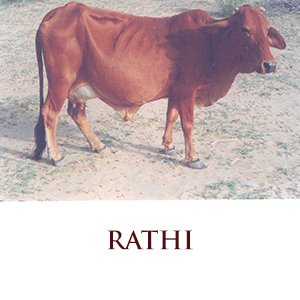Rathi

Rathi is an important dual purpose Indian cattle breed whose home tract lies in the heart of Thar desert. These animals are particularly concentrated in Loonkaransar Tehsil of Bikaner district, also known as the Rathi tract.
In addition, Rathi is also found in Ganganagar & Jaisalmer district of Rajasthan and in Fazilka & Abhror district of Punjab, adjoining Rajasthan. Farmers of this region, use this breed as a major source of livelihood.
The breed takes its name from a pastoral tribe called Raths who are Muslims of Rajput extraction and lead a nomadic life. Rathi cattle originates from the mixture of Sahiwal, Red Sindhi, Tharparkar and Dhanni breeds apparently with a predominance of the Sahiwal blood.
Characteristics:-
- These animals are of medium size with a symmetrical body and short and smooth body coat.
- Colour is generally brown with white patches all over the body though at times completely brown or animals with black coat and white patches are also found. Lower body parts are generally lighter in colour as compared to the rest of body.
- Face is broad between the eyes and slightly dished while the ears are of medium size.
- Forehead is lean and of medium size.
- Horns range from short to medium, curving outwards, upwards and inwards.
- Dewlap is fine, loose and voluminous.
- It has large naval flap and loose skin with fine short hair.
- Tail is long, fine and tapering to a good black or white switch well below the hock.
- Udder and teat are well developed with a prominent milk vein.
- Average lactation milk yield is 1500 kg, ranging from 1050 kg to 2000 kg.
- Average age at first calving ranges from 45 – 57 months and inter calving period from 13 – 15 months.
- Females are docile and good milkers (1325 to 2093 kg per lactation).
- Age at Maturity is 36-48 months.
- Body Weight for Male is 350-400Kg and Female is 280-300 kg.
Nomads own and breed these animails, generally move with their herds from one place to another depending on availability of water and grazing pasture. Wheat straw, pala leaves and chaffed sewan grasses are fed to animals. At times, chaffed sorghum and pearl millets are also substituted for grasses and leaves. Dry stalks of sorghum and pearl millet are fed in the lean season. Lactating animals are provided with concentrate mixture in proportion to their production. Shelter is not provided for these animals except during extreme weather.
Conservation Efforts
Like other native animals, Rathi breed is well-adapted to a hot climate , resistant to many diseases and hence they are used for crossbreeding in other countries. In India the number of pure-bred cattle including the Rathi breed is declining drastically.
Efforts to save these animals has been stepped up. Breeding farms are established for this breed at Bikaner and Hanumangarh. The Department of Animal Husbandry, Government of Rajasthan is currently engaged in breed improvement and veterinary health care & disease control programmes.
May the Rathi breed, as also the other pure Indian breeds, flourish.
Indian Cow Facts
Average lactation milk yield of Rathi breed is 1500 kg, ranging from 1050 kg to 2000 kg. The Department of Animal Husbandry, Government of Rajasthan is currently engaged in Rathi breed improvement and veterinary health care & disease control programs
